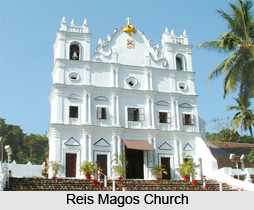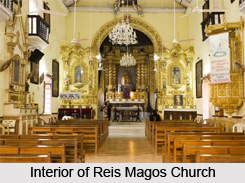 Reis Magos Church is the oldest church in Goa located at Reis Magos village, Panjim. The church is especially important from the point of view that this part of the village and the Reis Magos fort has got its name "Reis Magos" from it which symbolizes the Magi Kings, i.e. the Three Wise Men who went to Bethlehem after the shining star to bestow their gifts towards the Infant Jesus. Two of Goa"s former Viceroys are actually buried here, their tombstone inscriptions in Portuguese and Latin still clearly legible.
Reis Magos Church is the oldest church in Goa located at Reis Magos village, Panjim. The church is especially important from the point of view that this part of the village and the Reis Magos fort has got its name "Reis Magos" from it which symbolizes the Magi Kings, i.e. the Three Wise Men who went to Bethlehem after the shining star to bestow their gifts towards the Infant Jesus. Two of Goa"s former Viceroys are actually buried here, their tombstone inscriptions in Portuguese and Latin still clearly legible.
Foundation of Reis Magos Church
Reis Magos Church was built below the fortress walls in 1555, shortly after the construction of the fort itself. A Franciscan seminary was later added, and over the years it became a significant seat of learning. Historians have found evidence to support the fact that the church was built on the ruins of an old Hindu temple. Two typical symbols of the Hindu Vijayanagar temple architecture of lion figures can be seen on the flanks, at the start of the steps going up to the Church.
Structure of Reis Magos Church
The church remains as a golden landmark with its facade distinctive from the position of the church atop a flurry of steps with the full width of the church running across the Mandovi river bank.  The breadth of the church is enhanced by 5 doorways while slender Corinthian columns which divide the compartments provide the grace to its simplicity with its already strengthened impression through the high scroll decorated gable and an insignia of its crown adds to the royalty and dignity of this wonderful church of Goa.
The breadth of the church is enhanced by 5 doorways while slender Corinthian columns which divide the compartments provide the grace to its simplicity with its already strengthened impression through the high scroll decorated gable and an insignia of its crown adds to the royalty and dignity of this wonderful church of Goa.
A small shrine near the foot of the steps of the church dedicated to "Our Lady of Health" is erected on the site where Albuquerque had captured a Muslim outpost in 1510. Within the church restored in 1771, a dominant feature is a polychromed wooden panel of 3 gifts of gold, frankincense and myrrh offered to Infant Jesus seated on a kneeling Mother Mary. The wooden panel is placed on a reredos above the large central space containing the tabernacles surrounded by the 4 evangelists, which makes it all the more interesting and worthwhile watching it.
The colourful interior contains the tombs of three viceroys, including Dom Luis de Ataide, famous for holding 100,000 Muslim attackers along with their 2000 elephants at bay for 10 months in 1570, with his own force of just 7000 men.
Celebration at Reis Magos Church
Every year on the 6th of January, Reis Magos comes alive with the colourful "Festa dos Reis Magos", when the story of the "3 Kings" is re-enacted by local youth playing the parts of the Magi. The locals celebrate the journey of the three kings who went to worship the holy Infant Jesus with a procession which starts from the Church and goes around the village.





















